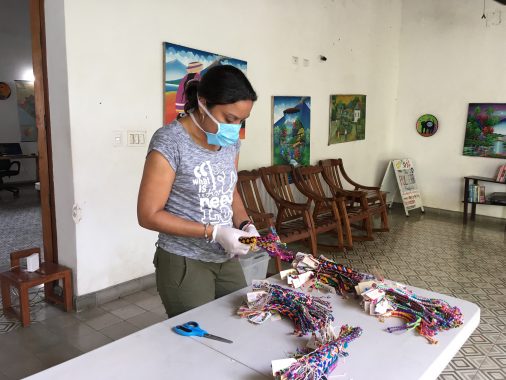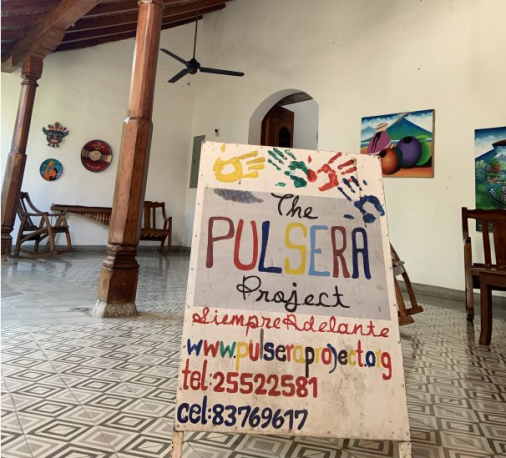

The Social Impact Project is a five-week consultancy project completed by second-year ESMT Berlin Master in Management students. This project allows us, the students, to gain practical experience while having a direct impact on an organization with specific social goals.
My team, which was formed by Fidan, Patricia, Chen-Ya, Milos and I, had the chance to work with the Pulsera Project, a non-profit organization with headquarters in Nicaragua and presence in Guatemala and the United States. We decided to work with them because we were really impressed by the creative solutions that they try to implement to tackle important social issues, such as poverty and social injustice.
Nicaragua and Guatemala are among the poorest countries in the western hemisphere, and in addition to this poverty, they suffer from other issues such as inequality and poor working conditions. Latin America is a region where informal labor is normalized, and a good portion of the population depends on whatever money they can make on a given day to feed their families and themselves.
This condition creates and enforces a vicious cycle of poverty. If one is born into these conditions, it is quite hard to get out. Children usually have to support their parents financially, thus renouncing the possibility of getting an education. The Pulsera Project believes that small actions can tackle these issues, one step at a time.
For instance, they act in two different ways. One is in developing countries such as Nicaragua, where they partner up with around 200 artisans to create pulseras (handwoven bracelets) under fair trade principles. The other is in the US, a developed nation, where they partner up with schools by providing educational materials so that students can reflect and come up with their own solutions to tackling these issues. Through this educational program, the pulsera sales are incorporated. Students oversee selling the pulseras for $5 and the proceeds are sent back to Nicaragua and Guatemala, to fund their operations and invest in the artisans and their communities.

We decided to work with them because we were deeply impressed by the work they’ve done so far, their mission, and their organic growth. Being part of such an inspiring project was a huge driver for us.
The organic growth they have experienced means that the word has spread across continents and many people want to have the Pulsera Project in Europe. However, due to limited time and resources, the organization has not explored the possibility to bring the educational materials to Europe. When we approached them, we were given the challenge to investigate possible ways to enter the European market.
First of all, it was important for our client to have us understand what their mission was all about. As a result, our first goal was to develop a deep understanding of the Pulsera Project so that the subsequent steps could use this as a guiding principle. To fulfill this goal, we went over their year-end reports, social media, and website materials.
Secondly, we looked at the educational systems of European countries, in order to select the ones that were the most appropriate. In the US, the Pulsera Project owes much of their success to service-learning programs, which are part of the curriculum in middle and high schools. Service-learning programs are built by combining academic material, practical experience, and civil engagement.
For instance, in the US, they mainly partner up with Spanish teachers, creating relevant material for their students through which they have the chance to learn about the conditions in developing nations. Afterwards, they provide a reflection opportunity where students can analyze the impact that they have on these nations, and how they can affect change. The last component, civil engagement is fulfilled through pulsera sales, where students prepare and manage their own stands for the sales while providing background information to potential customers.
Our idea was to evaluate the feasibility of implementing a similar program in the educational systems of 16 countries in Europe. Through a qualitative analysis based on six criteria we jointly defined with our client, we concluded that Spain and the UK should be the area of focus for the third step, our market research. These countries have a strong service-learning “infrastructure”, similar projects in the past, and an affinity with the Central American region.
The market research was then focused on how to start operations in these countries. We conducted interviews with experts in the service-learning field and concluded that it would not be wise to set up an office from the start. Instead, they gave us the idea to partner-up with NGDOs (non-governmental development organizations), investigate sister cities (cities in Nicaragua/Guatemala that hold a partnership with cities in Spain/UK), and foreign language conferences.
After prioritizing, we found that starting operations by partnering up with an NGDO would be the best way to start. We looked into more than 400 organizations and after careful consideration and analysis, we narrowed down our search to 28 organizations, which were ranked according to their potential for synergies. For this step, our learnings from the strategic international management course were useful, as it provided a framework to analyze the organizations and come up with the best possible recommendation for our client.
In the end, we delivered a final report with all the relevant documentation we had gathered and the analysis we had made. Additionally, we decided to create a pitch deck so they can approach these organizations to explore a possible collaboration.
At the start of the project, we thought we had a big mountain to climb. Our client had high expectations and a lot of work needed to be done to ensure a successful completion. Fortunately, they were very flexible and committed to the project. We were in constant communication with them and in the end, the regional director, Evan Durand, was like an additional member of our team. The involvement from their side helped us fulfill the project in a timely and appropriate manner.
Apart from the frequent support from Evan, we also had the opportunity to be mentored by Arianna Molino, a consultant from Kearney. She helped us provide structure to our deliverables and gave us hints for where to look for the information and how to evaluate it.
We were all looking forward to travelling to Nicaragua and meet the team there. However, due to COVID and the difficulties to travel, in the end, I was the only one who was able to go. During my visit, I had the chance to meet part of the Pulsera Project team, learn firsthand about what they do and got to know their offices and initiatives in Nicaragua. For instance, apart from the jobs that they provide, they also conduct frequent workshops with artisans related to economics, fair trade, and weaving.
For the most part, our project was carried out remotely. We were able to collaborate across 4 timezones; the US team was in California, our mentor was in Dubai, and our team was split between Nicaragua and Germany. It was quite an interesting experience to collaborate with people from all over the world working towards a common goal. This just highlights the times that we live in and the prospect of work not bounded by national borders and physical presence.
Throughout our meetings with the client, we were challenged on many of our world views. We came to realize that we had the wrong perception about social work. In most cases, unfortunately, social work comes from a vertical premise, and it should be applied horizontally. Additionally, we discussed at great depth the impact that we have on a lot of people in developing nations. For instance, when a shirt is listed for $5, it means that someone down the value chain is working under inhumane conditions to make it possible. We have been challenged to change our consumption habits and recognize how through our own behavior we can inflict change at a greater scale.
From my perspective, this was a truly valuable experience, and definitely one of the highlights from my time at ESMT. I feel that we had the chance to apply many of the lessons we had learned during the MIM program, especially strategic international management, organizational behavior, and judgment and decision making. These courses helped us develop frameworks that guided us through our project.
Moreover, I think we have developed a more optimistic outlook about the future. There’s a lot wrong with the world, but through initiatives like the Pulsera Project, we can make a change and help people move forward. We hope that soon the Pulsera Project is able to come to Europe and as a result, expand the artisan network and social contributions in developing nations.
